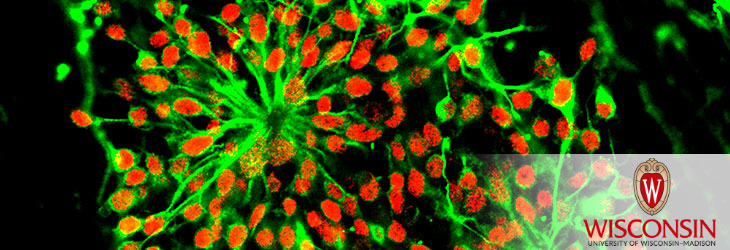Pluripotent Stem Cells

Patch for Delivering Therapeutic Cells into Heart
WARF: P110346US02
Inventors: Eric Schmuck, Kurt Saupe
The Wisconsin Alumni Research Foundation (WARF) is seeking commercial partners interested in developing a new type of epicardial patch for treating damaged heart tissue.
Overview
Throughout a person’s lifetime the heart undergoes slow cellular turnover. This steady regeneration is critical to maintaining healthy cardiac function from birth to old age. The heart’s ability to replenish itself is severely weakened following a heart attack, disease or other injury.
One approach to healing damaged hearts is to introduce potentially therapeutic cells, such as stem cells. Directly injecting cells into a beating, unstable heart is challenging and has been met with mixed success. An alternative method is to preload the cells into an epicardial ‘patch’ that can be affixed to a desired area of the heart. The cells release and migrate into tissue where they facilitate regeneration.
This approach has been investigated using patches made of synthetic materials as well as naturally occurring biomaterials. One problem is that none of these patches are derived from heart-specific cells, which can incite an anti-inflammatory response. Also, they must be glued or sutured to the heart and may fall apart.
One approach to healing damaged hearts is to introduce potentially therapeutic cells, such as stem cells. Directly injecting cells into a beating, unstable heart is challenging and has been met with mixed success. An alternative method is to preload the cells into an epicardial ‘patch’ that can be affixed to a desired area of the heart. The cells release and migrate into tissue where they facilitate regeneration.
This approach has been investigated using patches made of synthetic materials as well as naturally occurring biomaterials. One problem is that none of these patches are derived from heart-specific cells, which can incite an anti-inflammatory response. Also, they must be glued or sutured to the heart and may fall apart.
The Invention
UW–Madison researchers have developed a new epicardial patch derived from cardiac-specific cells that can adhere to the heart without glue or sutures. The patch may be preloaded with stem cells, skeletal myoblasts or any other potentially therapeutic cell to treat injured or damaged hearts.
The patch is made of isolated three-dimensional cardiac extracellular matrix (ECM). Its composition mimics natural cardiac ECM. Along with other components, it is made up largely of the structural proteins fibronectin, collagen and elastin.
The patch is made of isolated three-dimensional cardiac extracellular matrix (ECM). Its composition mimics natural cardiac ECM. Along with other components, it is made up largely of the structural proteins fibronectin, collagen and elastin.
Applications
- Epicardial patch for treating heart disease or injury
Key Benefits
- New patch is myocardial in origin and composition.
- Three-dimensional structure is more natural.
- Affixes readily – no glue or sutures
- Moves flexibly with the heart
Stage of Development
A patch was tested on a mouse model of myocardial infarction, as well as on its ability to release human mesenchymal stromal cells into heart muscle tissue.
The development of this technology was supported by WARF Accelerator. WARF Accelerator selects WARF's most commercially promising technologies and provides expert assistance and funding to enable achievement of commercially significant milestones. WARF believes that these technologies are especially attractive opportunities for licensing.
The development of this technology was supported by WARF Accelerator. WARF Accelerator selects WARF's most commercially promising technologies and provides expert assistance and funding to enable achievement of commercially significant milestones. WARF believes that these technologies are especially attractive opportunities for licensing.
Additional Information
Related Intellectual Property
Tech Fields
For current licensing status, please contact Andy DeTienne at [javascript protected email address] or 608-960-9857